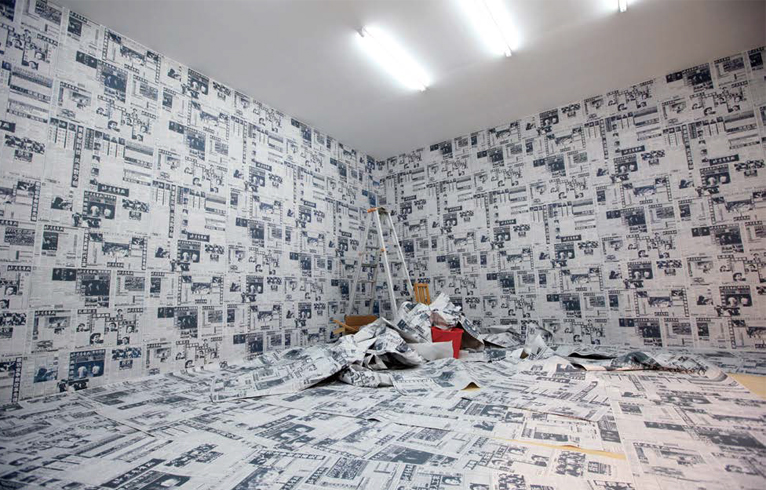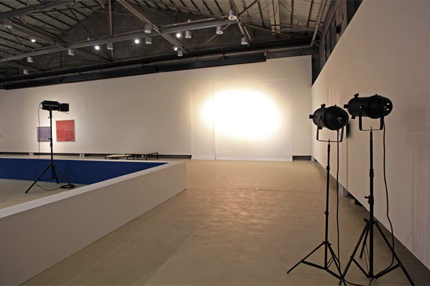THE SEVENTH SHENZHEN SCULPTURE BIENNALE
| October 16, 2012 | Post In LEAP 16

First, let us reproduce a scene from the eve of this exhibition, fleshed out, perhaps, with a bit of imagination. It is around midnight and you, an anonymous observer, have just checked into your hotel room, but are too impatient to wait until tomorrow to see the exhibition. So you decide to grant yourself a sneak preview. You have been told that the exhibition space will be on your left when you exit the hotel: about three hundred meters away. But as you take your first steps along the sloped sidewalk in search of your destination, you find yourself lost in a typical southern night market: red walls and green tiles, a myriad of human voices, and noisy karaoke halls. You are immersed in the flow of vibrant, weekend-touched masses. It is mostly a white-collar crowd; maybe you glimpse a famous architect talking business. But as for the actual purpose of this mission, it seems to have all been in vain. You retreat, spirits dimmed. But alas, at this very moment, the work of the artists and curatorial team is actually still underway, hidden away somewhere close in an enormous old factory; they might even be in the midst of reproducing Wang Youshen’s 1993 installation piece Newspaper – Interior Decoration. And lo and behold, the next day this newspaper-covered, pell-mell arrangement is indeed the first thing on display, the thick aroma of fresh work a testament to the fact that the layout was only just completed.
Only after arriving on site can we grasp the subtlety of these surreal circumstances: in a typical middle-class community, on an arid economy’s overgrown soil, this team of curators has taken an approach that is both heterogeneous and guerilla-esque. Here, the experience of haphazardness is something that just popping in and out of the opening reception, or even a guided exhibition tour, could not possibly provide. The curators of this exhibition are constantly defying convention at all levels— even down to the smallest details— in an effort to rid audience members of any comprehensive understanding of what they see before them. White walls and other forms of segmentation are set down as visual barriers. Sound works are deliberately placed in the same section so that they will conflict with one another. The exhibition’s two main spaces shun the idea of a recommended exhibition route, to the point where there are several “main entrances”; it doesn’t matter which one ultimately chooses, as there is seemingly no difference between then. Meanwhile, each work exists independent of its surroundings. The result is an abundance of textual material throughout: an ongoing information explosion.
The most classic example of this is Kelly Schacht’s interactive 2011 installation Un Tour d’Horizon. The work is easily overlooked at first, seemingly bland amidst the uproar as reporters swarm around the work and then pass over it. But when you return to face the piece anew in a nearly emptied exhibition space, it hits you easily and instantly. The young artist has enlisted several members of the audience (one of them, it seems, is blind), to watch her from different vantage points for an extended period of time as she hangs and moves about layers of large white screens. The audience is moved not only by the textual richness of the work and the critical take on the act of observation itself, but also, and more importantly, by the fact that the hired audience’s reflection upon what they see is actually entirely devoid of substance. The surreal nature of this partially staged behavior completely cuts into the rhythm and spatiality of the exhibition.
Little details similar to those in Schacht’s work abound. It might be said that the curatorial team, through some anarchist sacrifice, has distilled individuality from each artist. Consumers of culture-as-fast-food will inevitably experience the chaotic resurrection of this once rational platform as unapproachable; they will see it as a kaleidoscope that has been consciously positioned. But as we bring together more and more texts for reading, we discover that much pretext for criticism is merely meant to conceal an embarrassing and feeble reality anyway. In all documentary presentations of contemporary Chinese artistic practice post-1990, this very weakness is what ends up shining through. No matter how much curators emphasize the importance of “returning to the context of that time” or “respecting the work itself,” and no matter how diverse the strategies adopted for showing different works, the single unchanging fact is that, looking back over this period in history, the critics and the curators are absent from start to finish.

It is this reality that constituted the initial inspiration for this year’s biennial. In “Unexpected Encounters,” Zhang Xiaogang presents a letter he wrote in November 1990 to his friend Mao Xuhui. The most touching parts in the letter are Zhang Xiaogang’s ramblings. He does occasionally express his dissatisfaction with the critical discourse and commercial systems of the day, and of course his writing is peppered, as one might expect, with big terms like “construction” and “art qua art”— but what makes up the better part of his correspondence with Mao is a pure, simple exchange between two friends who happen to be “artists.” Even more thought-provoking in this section of the exhibition are publications from the 1990s: 1994 Contemporary Chinese Artists’ Agenda and Black Cover Book, White Cover Book, and Grey Cover Book. These truly valuable works were all organized, edited, and published by artists and artists alone, with the single exception being the ever-reputable Feng Boyi, the one art critic who appears in the Black/White/Gray series as an editor. This section also includes two 1994 exhibitions, “45 Degree as a Reason” and “Agreed to the Date 26 Nov. 1994 as a Reason,” which were sponsored by Geng Jianyi and organized entirely by artists at the time. From the artist-signed postcards on exhibit, it would seem that a world without critics and curators would be a happily harmonious one.
Perhaps the slightly biting tone here will estrange critics. But what 30 years of sheer fact tell us is that obedience to a single art historical logic inevitably leads to the omission of countless moments of brilliance in artistic creation. Take for instance Qian Weikang, an artist who ceased practicing altogether as early as 1996. His 1995 work Ventilating the Site used everyday ready-made products such as curtains and mechanical springs to engage in a simple and straightforward experiential navigation of the essence of the “object.” Of course, the discerning eyes of the mainstream dare not accept this disassociated, unfamiliar approach, but fortunately Qian protected his own subjectivity by simply quitting the game. Then there is Li Yongbin’s The Evidence of Life, 14 Days of Documentation, in which the artist piles soil into his own studio, sprinkles seeds, and spends 14 days waiting for the grass to sprout. Just this past March, He Yunchang also sat on the lawn of his own studio, awaiting the arrival of freshly bred young grass. Similar anxieties and expectations rear their heads in every generation without needing to be subject to any kind of logic at all. And if we approach the works from this perspective, only then are we able to begin to understand why the curators of this biennial would elect to bring in such an “alien” work as Wang Guangyi’s Quarantine – All Food is Potentially Poisonous (1996).
It can be said with conviction that this biennial marks the artists’ first successfully staged collective counter-attack, as critics and curators are “brought to justice” in this lifetime. But it is unclear whether the loosening or shifting of this sort of power structure is a good or bad thing. Today, we still see 1989 or 1993 as the watershed moments of contemporary Chinese art, and pin the macro-view of art history to this framework. True, this mode of historical construction has done its job to engender a number of schools of artistic thought and give birth to some of art’s newest upstarts, but in a globalized culture, this kind of thinking cannot possibly effectively advance China as an equal and active participant; the gap continues to deepen at the hands of outdated trains of thought. But then there is this biennial, offering no scarcity of new organizational approaches and possibilities. At the very least, as the works of China’s youngest artists are brought together with the works of artists abroad, everyone seems to be speaking the same language. Here, there is no system, so there is no gap.
Pu Hong (Translated by Katy Pinke)


